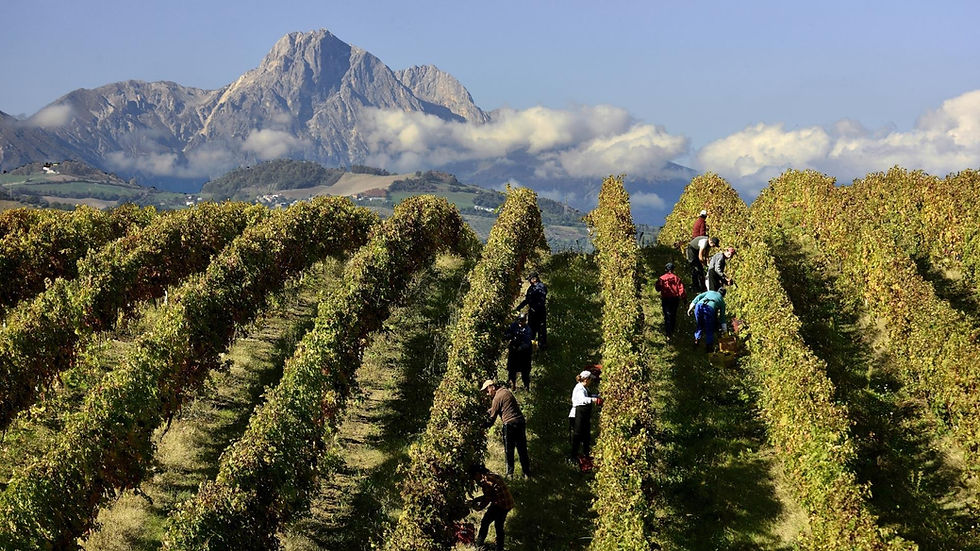Wine region in a nutshell: Abruzzo
- Koen van der Werf-Versteeg

- Apr 30, 2024
- 3 min read
In this blog series we introduce you to the most beautiful regions in the wine world. This time we are going to Abruzzo in the Italy we love so much. Perhaps not well known among us, but did you know that they have three National Parks here? And that there are even brown bears walking around there? In this blog you can read all about the region, the grapes and the wine. Avanti in Abruzzo!

Region and climate
Where exactly can we find Abruzzo? Let's do some visual thinking. If Puglia is the heel of the boot, then Abruzzo is pretty much its Achilles heel. The name is derived from the Latin Aprutium, which means 'land of the pigs'. North of Abruzzo you will find Marche, or the Marches. In Abruzzo you will find the highest mountain on the mainland in the Apennines, the Gran Sasso d'Italia, at 3000 meters. That makes the region very diverse.
Perhaps differently than expected, Abruzzo has a kind of mixture of a Mediterranean climate and a maritime climate. The closer inland you go, the warmer it gets. Summers are generally warm and dry. Yet it can get extremely hot and quite cold in winter. You can even ski there! Those warm summers and cold winters make Abruzzo ideal for wine growing. Yet, with 'only' 34,000 hectares, it is one of the smaller wine regions in Italy.
The most important areas
There are four provinces in Abruzzo. In terms of wine, two are really interesting - that's where you'll find the only DOCGs from Abruzzo. In the north this is Teramo. There you'll find Montepulciano d'Abruzzo Colline Teramane DOCG, promoted to the highest wine class since 2003. The soil is calcareous and clayey, with some sand and pebbles. The vines are relatively old with an average age of about 30 years. This results in slightly lower yields, but more taste.
In the south you will find the province of Chieti. That is where the Terre Tollesi DOCG or Tullum DOCG comes from, a DOCG since 2011. A super small area with only 19 hectares of vineyard. This DOCG is also especially for Montepulcianos, which are located around the town of Tollo.
That leaves two provinces. These are Pescara, which is sandwiched between Teramo and Chieti. Further inland you will find l'Aquila. They are of great significance because this is where the majority of the wine comes from, from seven DOCs.

The grapes
You can already feel it coming, lord and master of Abruzzo is the blue Montepulciano. Named after the town of Montepulciano, which is located in Tuscany). It is a versatile grape that does very well in Abruzzo. It has a thick skin, which gives it a deep color with sometimes quite a bit of tannin. These properties make it suitable for both smooth drinkers and strong guys. You taste black fruit with nice acidity. They are especially nice 'young' (and affordable)!
For the rest you will find two white grapes. First of all the Trebbiano. It often produces soft wines with aromas of white fruit, flowers and a hint of almond. The other is Pecorino, from the sheep's cheese of the same name. The story goes that the grape was so named because the sheep grazing in the vineyard loved this grape so much that they ate half the vineyard before it could be harvested. You smell a lot of citrus in it, with some anise and fennel. They are often full-bodied wines that also improve with age; you can safely keep them for 5 years.
What you really must have tasted...
...is Cerasuolo! What it is? It is rosé made from the Montepulciano grape. And because this grape has a thick skin with lots of color, so does the rosé. You could almost call it candy pink. And that intense color is also reflected in the taste. Most Cerasuolos have aromas of cherry, accompanied by notes of raspberry and pomegranate. Very fruity. That makes it a wonderfully attractive wine for in the sun on the terrace, or as a wine with light starters. You have to look for it, because Cerasuolo is not standard in every wine shop. But definitely worth a taste!





Comments